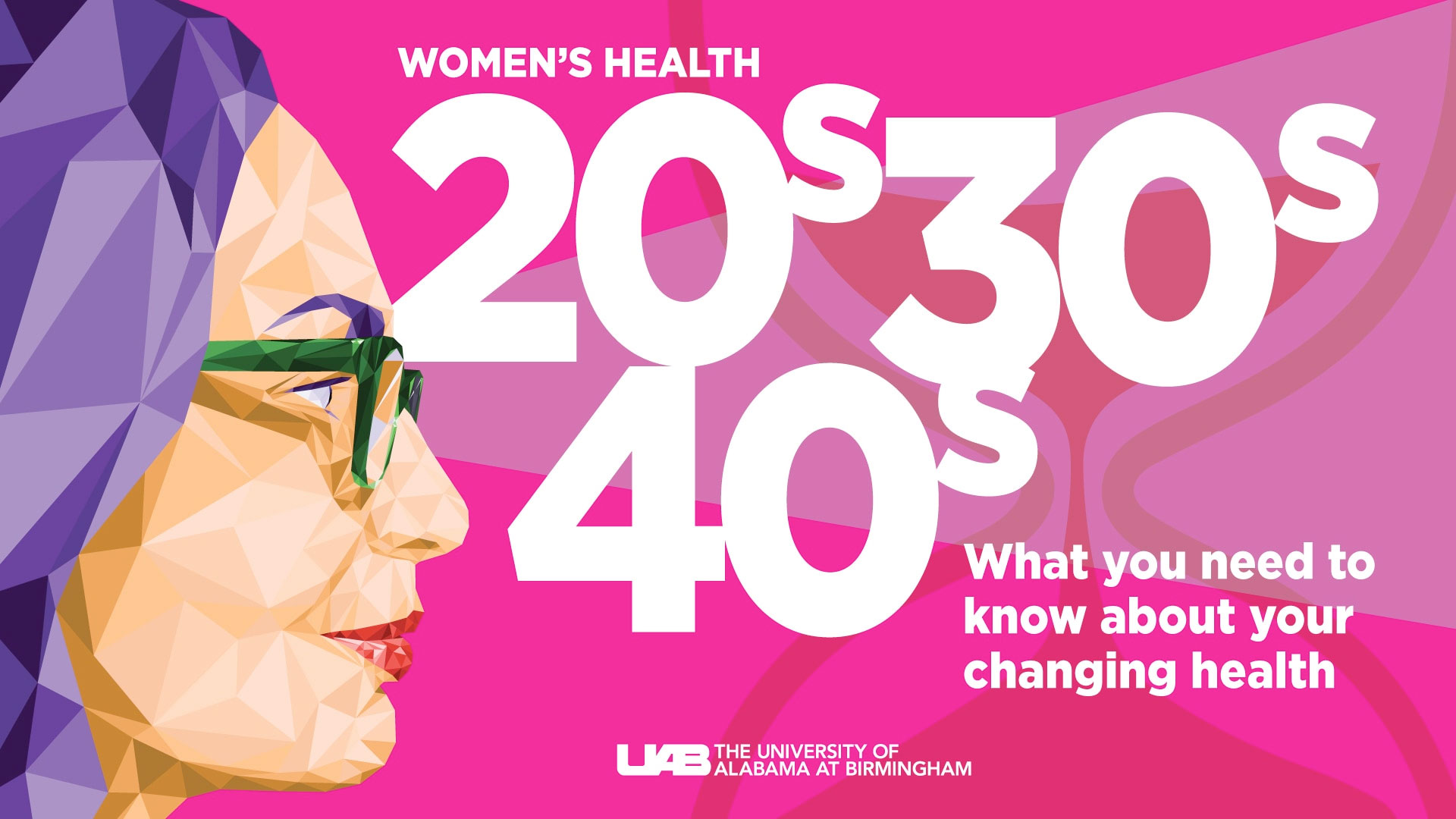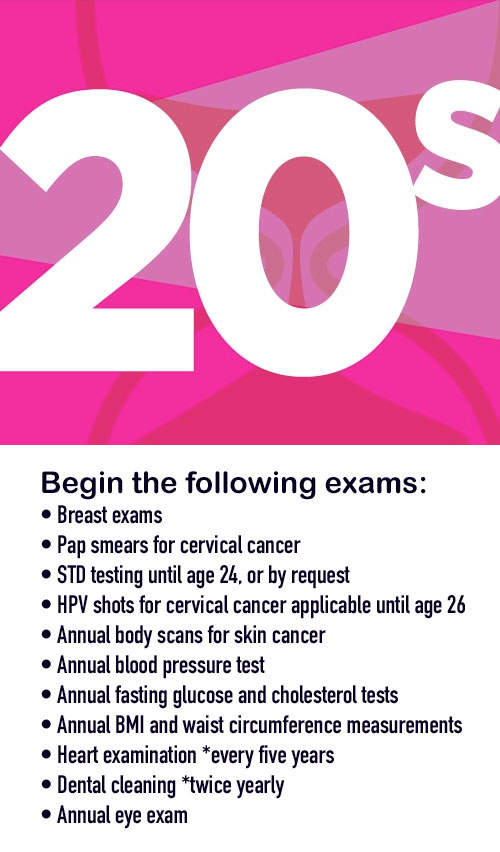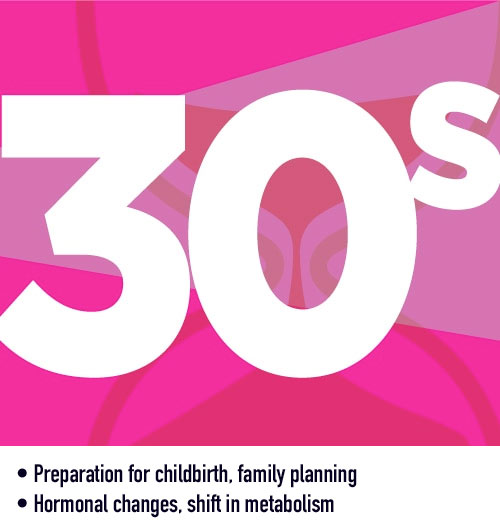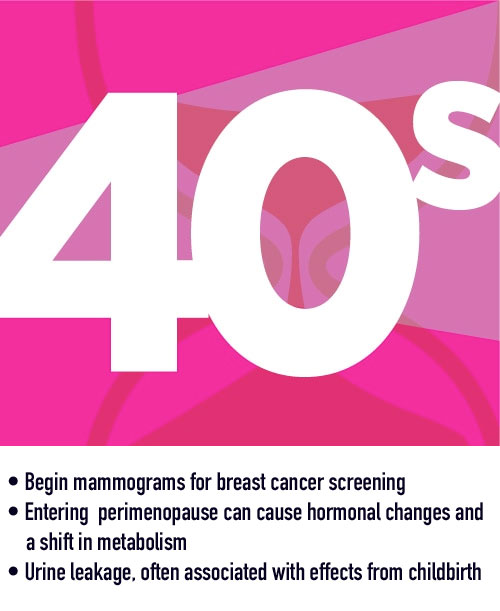 Regular physician visits and medical screenings are critical to maintaining one’s health. However, women are often unsure about what tests they need and at what age, which doctors they should be seeing annually, and what physiological changes they may experience at certain ages.
Regular physician visits and medical screenings are critical to maintaining one’s health. However, women are often unsure about what tests they need and at what age, which doctors they should be seeing annually, and what physiological changes they may experience at certain ages.
To clear up confusion, experts at the University of Alabama at Birmingham shared changes women should be aware of as their bodies mature, questions they should ask their doctors, and when they should receive specific medical exams during their 20s, 30s and 40s — timely with Women’s Health Week.
While each woman’s needs are different, having open conversations with physicians will help them navigate their individual health journeys, enabling them to anticipate changes they may experience in the coming years and how they can optimize their health care to best suit their needs.
Gynecological care
As a gynecologist tends to be the primary and constant physician that most adult women see on a yearly basis, many wonder if it is OK to view that appointment and relationship as one for primary care as well. Audra Williams, M.D., assistant professor in UAB’s Department of Obstetrics and Gynecology, explains that, yes — particularly in your 20s and early 30s — seeing just your gynecologist if you are a normal, healthy adult is sufficient.
 “When women come for their annual screenings, we do much more than just pelvic exams — we do an overall health screening, test their blood pressure and weight, dive into a woman’s family history, and identify any health risks they may have or be predisposed to,” Williams said. “We take a full body approach to our care and then recommend other physicians as needed to address other health concerns women may have.”
“When women come for their annual screenings, we do much more than just pelvic exams — we do an overall health screening, test their blood pressure and weight, dive into a woman’s family history, and identify any health risks they may have or be predisposed to,” Williams said. “We take a full body approach to our care and then recommend other physicians as needed to address other health concerns women may have.”
Williams explains that establishing a relationship with a gynecologist in your 20s not only is important for maintaining health, but gives you a trusted physician with whom you can discuss any questions or concerns relating to sexual function, family planning, fertility, breast awareness and more.
“As women’s needs change from their early 20s, when they may be more focused on sexual health and prevention, to their early 30s, when family planning is top-of-mind — even to their 40s, when urine leakage and perimenopause are prevalent — we as OB/GYNs guide our patients through all aspects of related concerns specific to women’s health,” Williams said. “We’re a one-stop shop in many ways.”
A gynecologist also serves as a key component in cancer detection and prevention. Whether by conducting a Pap smear for women 21 and older for cervical cancer, administering HPV shots, or doing routine breast exams to check for abnormalities before a woman may be due for a mammogram, women can assure that their gynecologist will develop a plan for tests and screenings tailored to their age and risk factors and refer them to appropriate specialists as needed.
Williams adds that, by their mid- to late 30s, women should see a primary care physician as well. While a gynecologist can test for things like cholesterol and diabetes, they may refer a patient to a primary care physician for further routine testing.
Heart health
Heart disease is the No.1 cause of death among women in the United States, translating to nearly one in every four female fatalities. Oftentimes, women who die of heart disease are asymptomatic; but women possess unique risk factors and symptoms that can be prevented and treated if they are aware of what to look for.
Salpy Pamboukian, M.D., director of UAB’s Women’s Heart Health Clinic, recommends that, starting in a woman’s 20s, she should receive yearly testing for blood pressure, fasting glucose, cholesterol, body mass index and waist circumference to gather vitals that indicate a her heart health state.
“When a woman is in her 20s, it’s sufficient to receive a heart examination every five years; but once they enter their 30s, we recommend every two to three years,” Pamboukian said. “Once they hit their 40s, it’s key to get heart examinations every two years or even more frequently, as needed.”
Pamboukian notes that additional testing may be recommended if you have a family history of heart disease or if you have known risk factors for heart disease, such as smoking, high blood pressure, elevated cholesterol, diabetes or obesity.
“We outline general guidelines and know that each woman is different. When in doubt, talk to your doctor and see what course of treatment may be best for you,” Pamboukian said.
Dermatology
Skin cancer is the most common cancer in the United States, but regular body scans by your dermatologist can assist in early detection of any questionable and potentially cancerous spots. Holly Gunn, M.D., assistant professor in UAB’s Department of Dermatology, recommends that women begin seeking yearly visits with their dermatologist in their early 20s to ensure that there are no abnormalities. Once a dermatologist gets an understanding of that patient’s skin type and medical history, they can then determine the frequency of visits moving forward.
 “It’s key that women are coming to see their dermatologist throughout their life span to get body checks and understand their individual risks, as each body responds differently to sun exposure,” Gunn said. “From there, we work with the patient to set expectations on the frequency of future body scans. For instance, some darker-skinned women may need to visit only once every three years, while a someone with fair skin may need to come yearly or more.
“It’s key that women are coming to see their dermatologist throughout their life span to get body checks and understand their individual risks, as each body responds differently to sun exposure,” Gunn said. “From there, we work with the patient to set expectations on the frequency of future body scans. For instance, some darker-skinned women may need to visit only once every three years, while a someone with fair skin may need to come yearly or more.
“Each body is different, and it’s key that women understand how to identify lesions that may not look normal or that have appeared since their last visit.”
Gunn stresses that regular exams are even more critical for women in their 20s, 30s and 40s who currently are or may have been regular tanning bed users in the past. Those who have used tanning beds are eight times more likely to develop skin cancer.
In regular body scans, education is top-of-mind, as Gunn points out.
“What we really try to accomplish in our body scans beyond looking for cancerous marks is to help educate women about what looks normal and what doesn’t — the ‘ugly duckling’ marks that tend to catch an eye, the marks that have grown quickly, or a mark that may be nothing but is still best to get looked at,” Gunn said. “If these scans help women identify marks on their own bodies or even their husband’s, family members’, children’s, or friends’, that regular visit was worth it and can save other lives.”
Gunn recommends that women of all ages regularly wear sun screen with an SPF of 30 or higher and reapply every two hours or even more frequently if sweating or swimming. Whether you’re out for a walk with a friend, lying on the beach, or watching your child play sports, sunscreen and appropriate layers like hats or long-sleeved shirts should always be top-of-mind in protecting your skin. She also reminds patients to check expiration dates for sunscreens as well — they should be replaced regularly to ensure optimum protection.
Oral health
People are always reminded to visit the dentist two times a year for regular cleanings; but as women approach their window for conception and pregnancy, only 25 percent of women actually visit the dentist.
“It’s the recommendation that women who plan to get pregnant within a six-month window or those who are currently pregnant visit the dentist to ensure they have a healthy mouth, which can impact other aspects of their pregnancy and delivery,” said Mia Geisinger, DDS, associate professor in UAB’s Department of Periodontology. “There’s a myth that it’s unsafe for pregnant women to visit the dentist, and that’s false. It’s actually the recommended standard of care, as up to 70 percent of women will experience gingivitis or gingival inflammation during their pregnancy.”
 Geisinger includes that, in the years leading up to childbearing and during pregnancy, there are tremendous physiological changes that occur, and many appear in a woman’s mouth. High rates of gingival inflammation are tied to preterm births, and issues such as inflammation can be monitored and treated by your dentist during this time.
Geisinger includes that, in the years leading up to childbearing and during pregnancy, there are tremendous physiological changes that occur, and many appear in a woman’s mouth. High rates of gingival inflammation are tied to preterm births, and issues such as inflammation can be monitored and treated by your dentist during this time.
As women enter their late 30s, they are likely to experience gum recession and increased cavity rates, be it from diet or lack of saliva production as a side effect from medications. When a woman enters her 40s, there is potential for a decrease in bone density in the jaw and tooth loss, a new territory in oral health care for many women.
“While your late 30s and 40s are not classified as geriatric, this is a time when women need to be cognizant of things they may be experiencing such as perimenopause. This time of a woman’s life does bring changes to their oral health care and routines, and a dentist can guide them through these times with personalized care,” Geisinger said.
Eye health
While there are no eye conditions that specifically impact or cause concern for women during their 20s, 30s and 40s, Terri Call, O.D., assistant professor in UAB’s School of Optometry, suggests that women ages 20 to 40 see their optometrist for routine eye exams on an annual basis.
“Routine eye exams for women during these times of life are generally sufficient, as we do a full exam of the woman’s overall eye and vision health,” Call said. “However, it is worth noting that, as women age, their vision changes as well, and they may experience the need for reading glasses for the first time or their prescription may change.”
Call explains that dry-eye disease tends to become more prevalent in women as they approach menopause, so if women experience dry eye during their 40s, it is best to schedule a dry-eye workup outside of their annual visit if symptoms persist.
